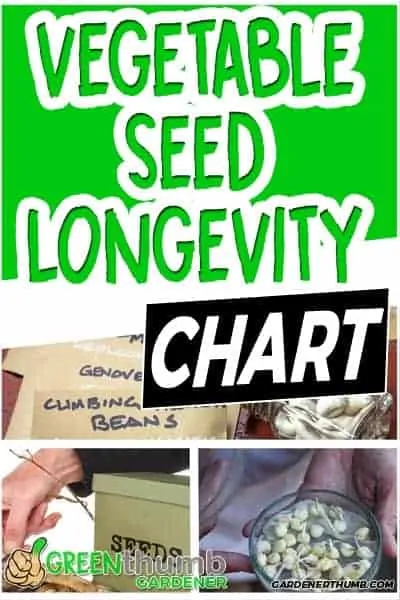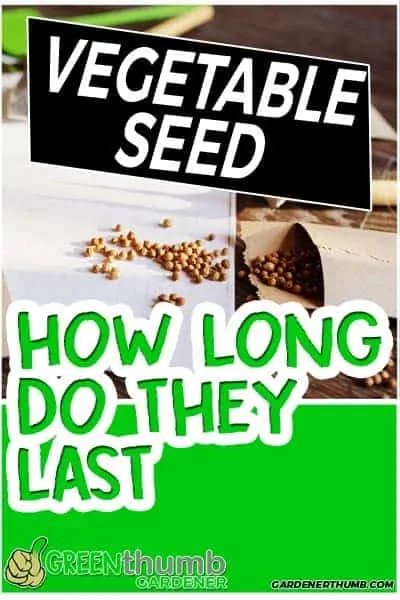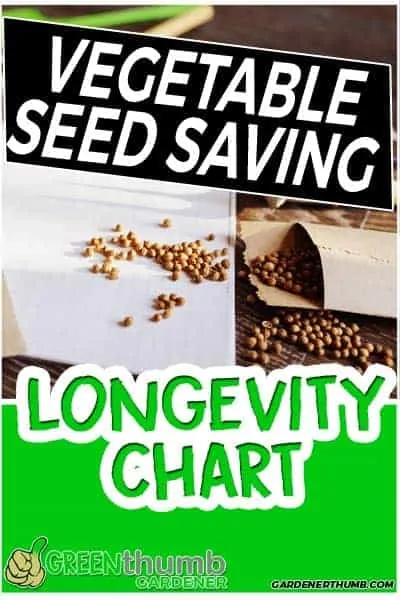How Long Are Vegetable Seeds Good For | Chart & Storage Guide
Last updated: 10/31/21
Despite looking brittle and dry, vegetable seeds may, in fact, be very much alive and carrying the embryo of what will in the future grow to be a full-sized plant.
Many vegetable seeds have the ability to stay viable for years. However, some, including onions seeds, deteriorate in less than a year
Green thumb Gardener occasionally links to product and/or services offered by vendors to assist you with all your gardening needs. Some of these may be affiliate links, meaning we earn a small commission if items are purchased.
Want to Download a Garden Hack Guide for FREE

Enter your email below and we will send you a guide to help you SAVE money in your garden.
On the opposite end, tomato seeds can sprout even after 10-15 years.
Believe it or not, we sprouted some 8-year seeds ourselves.
Essentially, the longevity of vegetable seeds depends on the type of seed as well as the method of storage.
Given that deciding a seed’s viability using only an eye test is often misleading, methods and steps for testing for germination will also be discussed here, along with recommendations for keeping seeds viable for longer.
We will stick with the very basic methods of seed storage.
Check out this publication here for more detailed charts of germination rates

Chart of How Long Do Vegetable Seeds Last
You can download or print this out here.
| Vegetable | Years Viable (in cool dry conditions) | Green thumb Gardener Notes |
| Asparagus | 3-5 | 50% germination for 5 years. Commercial seeds must be at least 75% viable |
| Beans | 3 | 50% germination for 3 years. Commercial seeds must be at least 80% viable |
| Beets | 4-6 | 50% germination for 6 years. Commercial seeds must be at least 75% viable |
| Broccoli | 3-5 | 50% germination for 5 years. Commercial seeds must be at least 75% viable |
| Brussels Sprouts | 4 | 50% germination for 5 years. Commercial seeds must be at least 75% viable |
| Cabbage | 4 | 50% germination for 5 years. Commercial seeds must be at least 75% viable |
| Carrots | 3 | Germination rates fall off steeply after 3 years. Commercial seeds must be at least 55% viable |
| Cauliflower | 4 | 50% germination for 5 years. Commercial seeds must be at least 75% viable |
| Celery | 3-8 | 50% germination for 8 years. Commercial seeds must be at least 55% viable |
| Chives | 1-2 | 50% germination for 2 years. Commercial seeds must be at least 70% viable |
| Corn | 3 | 50% germination for 3 years. Commercial seeds must be at least 75% viable |
| Cucumber | 5-10 | Commercial seeds must be at least 80% viable |
| Dill | 4-5 | 50% germination for 5 years. |
| Eggplant | 5-7 | 50% germination for 5 years. Commercial seeds must be at least 60% viable |
| Kohlrabi | 3 | Commercial seeds must be at least 75% viable |
| Leek | 3-6 | 50% germination for 3 years. Commercial seeds must be at least 60% viable |
| Lettuce | 5 | 50% germination for 5 years. Commercial seeds must be at least 75% viable |
| Onion | 1-2 | 50% germination for 2 years. Commercial seeds must be at least 70% viable |
| Parsley | 1-3 | 50% germination for 3 years. Commercial seeds must be at least 60% viable |
| Peas | 3 | 50% germination for 5 years. Commercial seeds must be at least 80% viable |
| Pumpkin | 4-6 | 50% germination for 6 years. Commercial seeds must be at least 75% viable |
| Radish | 5 | 50% germination for 5 years. Commercial seeds must be at least 75% viable |
| Spinach | 3 | 50% germination for 5 years. Commercial seeds must be at least 65% viable |
| Squash | 4-6 | 50% germination for 6 years. Commercial seeds must be at least 75% viable |
| Tomatoes | 4-10 | Commercial seeds must be at least 75% viable |
| Turnip | 4-5 | 50% germination for 5 years. Commercial seeds must be at least 75% viable |
| Zucchini | 4-6 | 50% germination for 6 years. Commercial seeds must be at least 75% viable |
Methods of Storage
The first method for storing seeds is drying. If the seeds are being gathered and saved from one’s own plants, it’s best to spread the seeds on a newspaper and allow them to airdry for the space of a week.
As an additional precaution, it’s advised to write the seed names on the newspaper to avoid mix-up.
After they are dried, the seeds can be packed into small envelopes or paper packets that are labeled with the plant name and other relevant details.
Something to remember is that saving one’s own seeds, it’s best to plant open-pollinated varieties.

Those will come back true while hybrids will not.
We love this case and use it for our seed storage. It is a photo case, but has separate containers for storage. It helps to keep organized for our commonly planted vegetable seeds.
We keep this in our basement out of the light and have not had any issues with our seeds.
Those will come back true while hybrids will not.
We love this case and use it for our seed storage. It is a photo case, but has separate containers for storage. It helps to keep organized for our commonly planted vegetable seeds.
We keep this in our basement out of the light and have not had any issues with our seeds.
Stashing Them Somewhere Airtight
When finished with packing the seeds, placing the packets inside food storage bags, particularly plastic ones, is a good call.
Other options include glass canisters that have tight-fitting lids and mason jars that have tight-fitting lids.
Keeping the seeds moisture free is a top priority.
That can be achieved by wrapping two or, at most, two and a half tablespoons of powdered milk in about three and a half layers of facial tissue, then placing the milk packet inside a storage container that has the seed packets.
On top of that, one can also add silica gel. This is meant to be replaced every six months.
Putting Containers in a Dry and Cool Place
Too much humidity can significantly decrease a seed’s shelf-life, making the refrigerator the best place to store them. However, it’s wise to keep them away from the freezer.
Storing seeds from the same year together is generally a good practice, as well as dating them. Given that most seeds stay viable for at least three years, it’s easy to know at a glance if a container has planting potential.
When it comes time to plant, an advisable thing to do is to remove containers from the refrigerator and to keep them shut until the seeds have warmed to room temperature.
Without doing this, air moisture may condense on the seeds, resulting in them being clumped together.
Despite how methodical, organized and careful one may be about storing their seeds, the fact is that some simply won’t germinate.
Two plants that home gardeners will find to have low germination rates are sweet corn and parsnip. Other seeds may only remain viable for one or two years.
Testing Seeds For Germination
Testing seeds for germination is neither very difficult nor a complicated process.
It requires a few materials and following a few steps as accurately as possible to get the best results.
The materials that are needed are:
- 10 seeds of each type that is being tested
- One or multiple zip-seal plastic baggies
- Paper towels (one for each kind of seeds being tested)
- Permanent marker for marking the seeds
- Labels that are cut from a plastic shopping bag. The last list item is only necessary when conducting multiple tests.
With all those materials in place, the first step is to dampen the paper towel. After dampening, it can be placed on the counter.
A good size that easily fits in a quart bag is regular size towel folded in two.
The second step is to place the seeds on the paper towel. It’s crucial not to mix seed types.
For example, if zinnias and tomatoes are being tested, the recommendable thing to do is to put tomatoes in one paper towel and zinnias in the other.
The third step consists of sealing the seeds in a plastic bag.
To do this, one may roll the seeds up as they are inside the paper towel while pressing softly to ensure that the seeds and the damp paper are in contact.
The following stage is to put the paper towel, with the seeds still inside, inside a plastic baggie before sealing it up.
Testing multiple types of seeds per bag means there will be a need to write down the seed type on a plastic label, preferably with a permanent marker, and then attach the label to the paper towel.
Alternatively, testing multiple seeds in different baggies requires labeling the seed type on the outside.
The fifth and most patience-demanding stage is waiting for seeds to germinate.
This involves placing sealed bags of seed packets somewhere warm and waiting to see whether or not they sprout.
Afterward, one may check the seeds every few days to see if they are germinating by tenderly unrolling the damp paper towel.
If they are still yet to sprout, they should be rolled back up and returned to the bag.
Results of The Germination Test
When the seeds have germinated, the results of the germination test can be calculated. It’s handy information to keep for the current round of planting and for future reference.
The way to do this is to count the number of seeds that have sprouted. Following this, one can multiply that number by 10.
For example, if 8 out of 10 seeds sprout, that’s a viability rate of 80%.
If the germinate rate is under 50%, it’s generally advisable to dispose of the seeds or plant more than the ones that are needed.
If the test is conducted at planting time, it’s recommendable to plant the seeds that are able to sprout in potting soil or to dispose of them and plant fresh ones from one’s original batch.
More Info
Saving Seeds is a necessary skill as a gardener & survivalist. It allows you to save some money while also building up your seed supply.
It is so easy to do, that everyone should at least practice it each year. Check out our seed saving fundamental guide here for some more tips & techniques on seed saving.
There are so many details on saving seeds that you can find in one of our absolute books that we have used throughout the years and where much of this information came from.
Related Questions
- How to store vegetable seeds? – The three crucial tenants for storing vegetable seeds are to protect it from moisture, heat, and light.
- How long do seeds remain viable? – Viability in seeds lasts approximately from 1-10 years depending on the vegetable seed.
- How long are herb seeds good for? – Herb seeds last approximately 3-5 years depending on the variety of herb.









